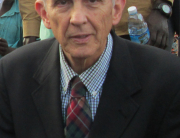by Dr. Gregory Bartha
March 28, 2018
David Olvera, a friend of mine who helps take care of my house and mail when I’m in Uganda, traveled to London with his son David Junior two years ago. They loved the city and were eager to return. Also, through his nursing work in Midland, David was helping care for an elderly man whose original home was in Denmark. David became acquainted with the gentleman’s nephew, who still lives in Denmark. He invited us to visit him there, so David was arranging another trip, this time to both London and Denmark, in the summer of 2017. He invited me to accompany him and his son. Since the timing matched with my scheduled return to Uganda, I agreed to go.
We spent three days in London and six days in Denmark. David had familiarized himself with London’s tube system, and this made our travel around the city much easier. We visited several of London’s famous museums – the British Museum, the Victoria and Albert Museum, and the National Gallery. We enjoyed the music, dance, and acrobatic acts performed on the streets for the visitors. We soon found that everything in London is much more expensive than in the US, so we limited our dining to low-cost fast food venues.
While in London, we had the opportunity to meet with Jaz, who assisted Ronald with his high school and college education in Uganda. Jaz is currently working with some organizations to help refugees in northern Uganda who have fled there to avoid conflicts in South Sudan and the Congo. I remember his statement, “It is a privilege, an honor, to be in a position to help other people. It should not be looked on as a burden or an obligation.” I updated Jaz on Ronald’s progress in the US, and he was pleased to hear that Ronald was doing well.
My impression of London is that it is such a solid, strongly built city; a place constructed for generations. I appreciated its openness, its expanse, and the beauty of its parks, trees and flowers.
Then off to Denmark. We arrived early in the morning and started exploring Copenhagen. It is much more compact than London; more dense. Most people live in apartments. Denmark is really a country of islands. Like London, Copenhagen has a long history and features many old, finely built structures, grand churches and palaces. It is lined with canals. We spent three days walking through the city. We particularly liked to Tivoli – the large park in the central city which had gardens, restaurants and amusement rides. The National History Museum had excellent exhibits showing Denmark’s development from the Bronze Age to the present.
Then David’s friend, Bent Andersen, met us and drove us to his home on another of Denmark’s large islands. Bent is a woodworking craftsman who has spent years making fine furniture, cabinets and doors. He has done much work in churches and is currently constructing a bell support in a church near his home. Bent toured us through several churches, then took us to see Fredericksborg Castle in Hillerod. It is a magnificent structure with the vast sculptured garden which rivals that of Versailles. Part of the castle was burned and then reconstructed, but the cathedral portion is unchanged and is most beautiful. The ceiling is covered with artwork, and there are many sculptures and paintings on the walls depicting the Crucifixion and Christ performing miracles. Anyone visiting Denmark should most certainly see Fredericksborg.
Bent’s home is in the small village of Alborg. It was built in 1882 and was originally a schoolhouse. He is hoping to convert this structure and the surrounding property to a residential school and artistic community for artisans and craftsmen.
The next day, we visited more churches and saw Marselisborg Palace in Aarhus, Denmark’s second city. There, we went to the Historical Museum, which is a brilliantly designed structure that is partially underground. It features many interactive exhibits and gives extensive information on the prehistoric peoples and Vikings. We also saw ancient burial grounds marked by large boulders.
We ended the day with a lovely dinner prepared by Bent’s friend Mitte. She lives in a fairly small apartment in Aarhus, but the design and arrangements are such that it contains a generous dining area, a grand piano and a small studio. She has a fountain and garden in front and a very attractive yard and garden in the back. Denmark is famous for its fine design, and her home is an excellent example. Mitte is a therapist who specializes in psychological trauma. She is a very active person and almost daily walks down to the ocean near her home and dips into the water, even on the coldest days in winter. We returned that night to Bent’s home and the next day, saw the ruins of 1000 year old Kalo Castle. We had lunch at Ebeltoft with a great view of the ocean and surrounding countryside. Then we boarded a train back to Copenhagen.
The next morning, I had breakfast with Arun, an old Midland friend. For several years, he has been working in Copenhagen for Maersk, a large shipping company. He likes Copenhagen but says the society is very homogeneous and closed. After years working closely with people at his company, he is just now being asked to visit and dine with them in their homes. Denmark is a very prosperous country. Poverty is rare but taxes are high. All healthcare and education are paid for by the government. The country is small; only 5 million population
Our journey was now at its end. David and his son left for the US, and I headed back to Uganda.





Recent Comments